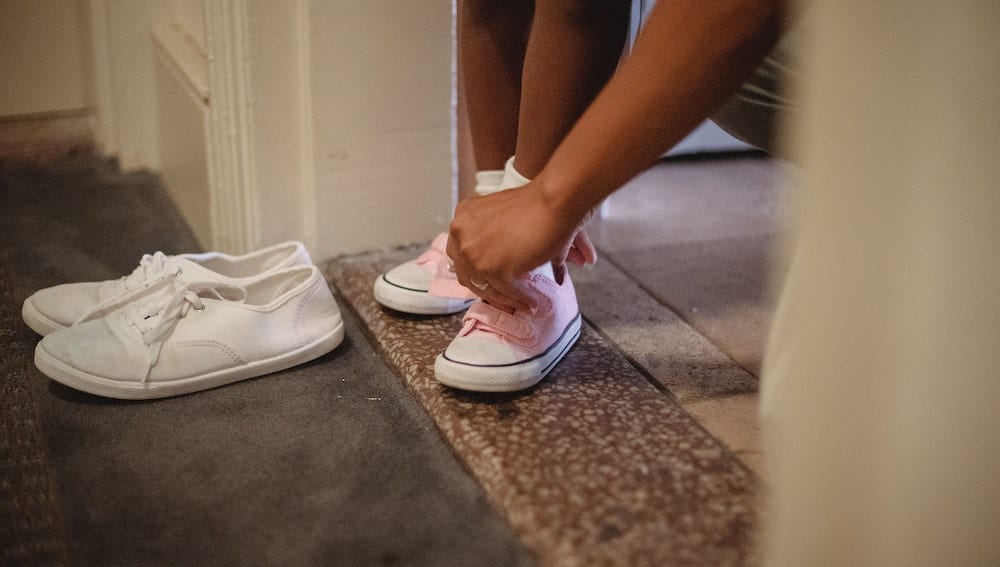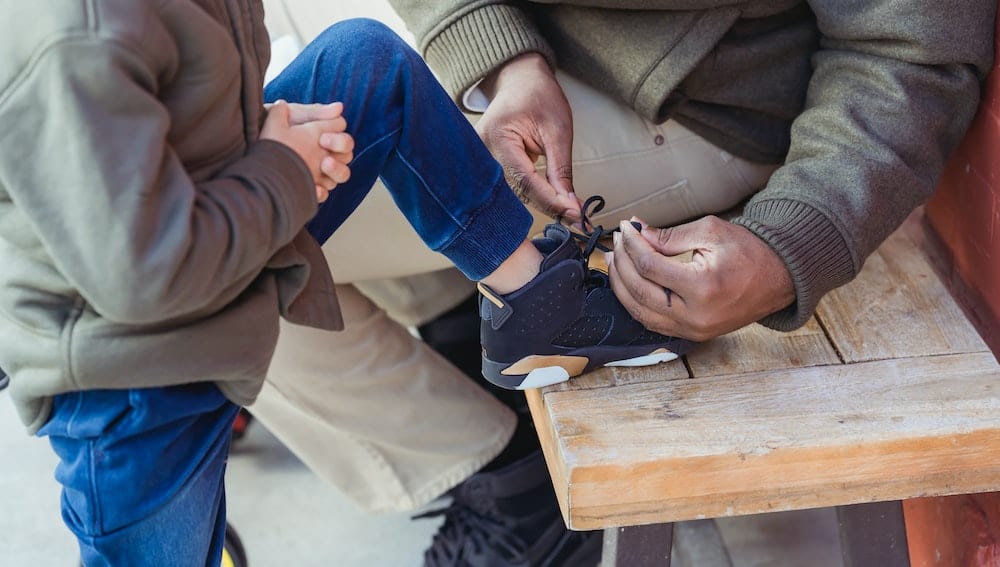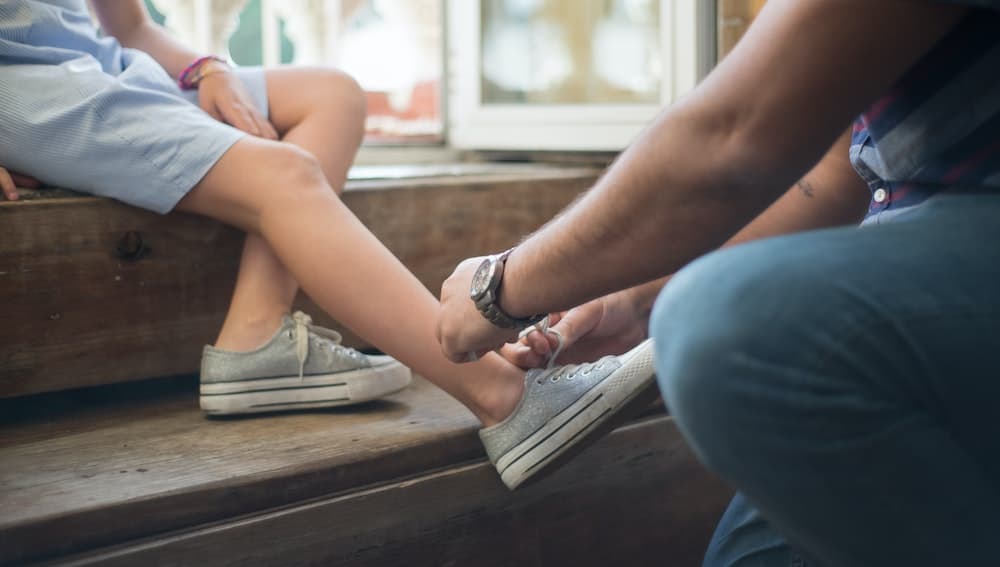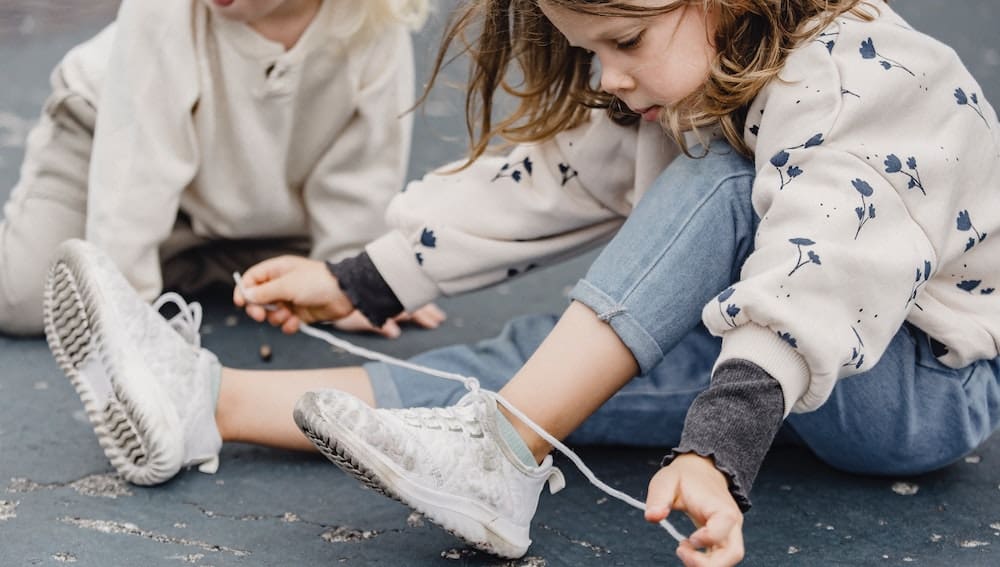When it comes to buying shoes for a 3-year-old, there are a lot of factors to consider.
Not only do you need to find a shoe that fits properly, but it also needs to be comfortable and appropriate for their age and development. With so many options available on the market, it can be overwhelming to know where to start.
Understanding shoe sizes is the first step in finding the right shoe for a 3-year-old. While age can be a helpful indicator of shoe size, it’s important to remember that every child is unique and may need a different size based on their individual foot shape and growth rate.
Measuring a child’s foot is the best way to ensure a proper fit, and there are a few different methods that can be used depending on the child’s age and ability to stand still.
Once you have an accurate measurement, you can begin to explore different brands and styles to find the perfect shoe for your little one.
Key Takeaways
- Understanding shoe sizes is crucial for finding the right fit for a 3-year-old.
- Measuring a child’s foot is the best way to ensure a proper fit.
- With so many options available, exploring different brands and styles can help you find the perfect shoe for your child.
Understanding Shoe Sizes
Choosing the right shoe size for a 3-year-old can be a challenging task for parents. It is essential to understand the basics of shoe sizes to ensure that the child’s feet are comfortable and well-supported.
Shoe sizes are typically measured in length and width. The length is measured in inches or centimeters, and the width is measured in letters, ranging from AA (narrowest) to EEE (widest).
The average shoe size for a 3-year-old is between 8 and 10 in the United States. However, it is essential to note that this can vary depending on the child’s foot size and shape.
Size charts can be helpful in determining the correct shoe size for a child. These charts usually provide a range of sizes based on the child’s age, foot length, and width.
However, it is crucial to remember that these charts are only a guide and may not be accurate for every child.
It is essential to measure a child’s foot to determine the correct shoe size. A child’s foot should be measured while standing, as this will provide a more accurate measurement.
The correct shoe size should allow for some room in the toe area and should be snug but not too tight.
Parents should also keep in mind that a child’s shoe size can change quickly as their feet grow. It is recommended to check the child’s shoe size every few months to ensure that they are wearing the correct size.
In conclusion, understanding shoe sizes is crucial when choosing the perfect shoe size for a 3-year-old. By measuring the child’s foot, using size charts as a guide, and checking the shoe size regularly, parents can ensure that their child’s feet are comfortable and well-supported.
Age and Shoe Size Correlation
The size of a child’s shoe is usually determined by their age, but there are many other factors that can affect this correlation.
A 3-year-old child typically wears a shoe size between 7 and 8 in the US, but this can vary depending on their individual growth and development.
It is important to note that children grow at different rates and may have different shoe sizes at the same age. Some children may have larger or smaller feet than average, which can affect their shoe size.
Additionally, factors such as genetics, nutrition, and physical activity can also impact a child’s growth and development.
Parents should ensure that their child’s shoes fit properly and provide adequate support for their feet. Ill-fitting shoes can cause discomfort, pain, and even injury.
It is recommended that parents measure their child’s feet regularly and purchase shoes that are the correct size and width.
In summary, while age can be a useful indicator of a child’s shoe size, it is important to consider other factors that can affect this correlation.
Parents should prioritize finding shoes that fit well and provide proper support for their child’s growing feet.
Measuring a Child’s Foot
Measuring a child’s foot is important to ensure that they are wearing the correct shoe size. A shoe that is too small can cause discomfort and pain, while a shoe that is too big can lead to tripping and falling.
To measure a child’s foot, follow these simple steps:
- Have the child stand on a piece of paper with their heel against a wall.
- Mark the paper at the longest point of their foot.
- Measure the distance between the wall and the mark on the paper to determine the foot length.
It is important to measure both feet, as they may not be the same size. Use the larger foot measurement to determine the correct shoe size.
There are also foot measuring devices available that can make the process easier and more accurate. These devices can be found at shoe stores or online.
When measuring a child’s foot, it is important to measure their feet regularly, as their feet can grow quickly. It is recommended to measure their feet every few months to ensure they are wearing the correct shoe size.
In summary, measuring a child’s foot is an important step in ensuring they are wearing the correct shoe size. By following these simple steps, parents can ensure their child’s shoes fit comfortably and properly.
Choosing the Right Shoe
When it comes to choosing the right shoe for a 3-year-old, there are a few factors to consider. The right shoe should be comfortable, supportive, and safe for the child to wear.
Here are some tips to help you choose the right shoe for your little one.
Fit
First and foremost, it is important to ensure that the shoe fits the child properly. Shoes that are too big or too small can cause discomfort and even lead to foot problems in the future.
It is recommended to measure the child’s foot before buying shoes and to choose a shoe that provides enough space for the toes to wiggle.
Support
Toddlers are still developing their balance and coordination skills, so it is important to choose shoes that provide adequate support. Look for shoes with a sturdy sole and good arch support. This will help prevent falls and injuries.
Type of Shoe
The type of shoe you choose will depend on the occasion and the season. Sneakers are a good option for everyday wear as they provide comfort and support.
Rain boots are a must-have for rainy days, while winter boots will keep little feet warm and dry in the colder months.
Material
The material of the shoe is also important. Shoes made of breathable materials such as leather or mesh will allow air to circulate and prevent the feet from getting sweaty and uncomfortable.
Safety
Finally, safety should always be a top priority. Look for shoes with non-slip soles to prevent slips and falls. Shoes with laces or velcro straps are also recommended as they provide a secure fit and prevent the child from tripping over loose shoelaces.
In summary, choosing the right shoe for a 3-year-old involves considering factors such as fit, support, type of shoe, material, and safety. By keeping these tips in mind, you can ensure that your child’s feet are comfortable, supported, and safe.
Shoe Size Conversion
When it comes to buying shoes for a 3-year-old, it’s important to get the right size. However, shoe sizes can differ depending on the country, and this can make it difficult to know which size to buy. T
hat’s where a shoe size conversion chart comes in handy.
A shoe size conversion chart is a table that shows the equivalent shoe sizes for different countries. It’s important to note that shoe sizes can also vary between different brands, so it’s always a good idea to try on shoes before buying them.
Here is a shoe size conversion chart for children’s shoes:
| US Size | UK Size | EU Size | Inches | Centimeters |
|---|---|---|---|---|
| 4 | 3 | 19 | 4.5 | 11.4 |
| 5 | 4 | 20 | 4.75 | 12.1 |
| 6 | 5 | 21 | 5 | 12.7 |
| 7 | 6 | 23 | 5.5 | 14 |
| 8 | 7 | 24 | 5.75 | 14.6 |
| 9 | 8 | 25 | 6.125 | 15.6 |
| 10 | 9 | 27 | 6.5 | 16.5 |
| 11 | 10 | 28 | 6.75 | 17.1 |
| 12 | 11 | 30 | 7.125 | 18.1 |
| 13 | 12 | 31 | 7.5 | 19.1 |
| 1 | 13 | 32 | 7.75 | 19.7 |
| 2 | 1 | 33 | 8.125 | 20.6 |
| 3 | 2 | 34 | 8.5 | 21.6 |
It’s important to measure a child’s foot before buying shoes, as this will ensure a proper fit. To measure a child’s foot, have them stand on a piece of paper and trace around their foot.
Then, measure the length from the heel to the longest toe. Use this measurement to determine the appropriate shoe size using the conversion chart.
When buying shoes for a 3-year-old, it’s also important to consider the type of shoe. Look for shoes that are comfortable, flexible, and provide good support.
Shoes with Velcro or slip-on closures can also make it easier for a 3-year-old to put on and take off their shoes independently.
Growth and Shoe Size
As children grow, their feet also grow in size. It is important to ensure that the shoes they wear are the right size and fit well to avoid any discomfort or injury.
Here are some things to keep in mind when selecting shoes for a 3-year-old.
Average Growth and Shoe Size
On average, a 3-year-old child will have a shoe size of around 8-9 in children’s sizes. However, it is important to note that every child is different and may have a slightly different shoe size.
As a general rule, it is recommended to measure a child’s feet every few months to ensure that they are wearing the correct shoe size.
Height and Shoe Size
Height can also play a role in determining a child’s shoe size. Taller children may have larger feet than shorter children of the same age. However, this is not always the case, and it is important to measure the child’s feet to determine the correct shoe size.
Choosing the Right Shoe Size
When selecting shoes for a 3-year-old, it is important to choose a size that is slightly larger than their current size to allow room for growth.
The shoes should also fit well and be comfortable to wear. It is recommended to have the child try on the shoes and walk around in them to ensure a good fit.
In summary, choosing the right shoe size for a 3-year-old is important for their comfort and safety. Measuring the child’s feet regularly and selecting shoes that fit well and allow room for growth can help ensure that they are wearing the correct size.
Gender and Shoe Size
When it comes to shoe sizes for 3-year-olds, gender plays a significant role. Boys and girls tend to have different average shoe sizes, and it is essential to consider this when selecting the right shoes for your child.
On average, girls’ shoe sizes are smaller than boys’ shoe sizes. For instance, the average shoe size for a 3-year-old girl is between 7 and 9 in the US, while the average shoe size for a 3-year-old boy is between 8 and 10.5.
However, these are just averages, and there can be significant variations between individual children.
It is crucial to measure your child’s feet accurately before purchasing shoes, regardless of their gender.
You can use a foot measuring device or take your child to a shoe store to get their feet measured by a professional. This ensures that the shoes you purchase fit well and are comfortable for your child to wear.
When it comes to selecting shoes for your child, it is also essential to consider the type of shoe and the activity your child will be doing. For instance, if your child is going to be playing outside, you may want to consider shoes with good traction and support.
If your child is going to be indoors, you may want to consider shoes with a non-marking sole to prevent scuffing.
In summary, gender plays a significant role in shoe sizes for 3-year-olds, with girls’ shoe sizes tending to be smaller than boys’ shoe sizes.
However, it is crucial to measure your child’s feet accurately and consider the type of shoe and activity when selecting shoes for your child.
Brand Influence on Shoe Size
When it comes to buying shoes for a 3-year-old, brand influence is a significant factor to consider. Different brands have different sizing charts, and some brands may run smaller or larger than others.
Therefore, it is essential to know the brand’s sizing chart before purchasing shoes for a child.
Some brands are known for their quality and durability, while others are popular because of their trendy designs. However, it is crucial to prioritize the child’s comfort and safety over brand influence.
A well-fitting shoe is necessary for a child’s healthy foot development, and it is essential to choose shoes that provide adequate support and protection.
Amazon offers a wide variety of shoe brands for children, making it easy to compare different brands and their sizing charts.
Some popular brands for toddler shoes include Nike, Adidas, Stride Rite, New Balance, and Crocs. It is essential to read reviews and check the sizing chart before purchasing shoes from a particular brand.
In conclusion, brand influence plays a significant role in choosing shoes for a 3-year-old. However, it is essential to prioritize the child’s comfort and safety over brand popularity.
It is crucial to research different brands, read reviews, and check the sizing chart before purchasing shoes for a child.
Also read: Shoes For Toddler With Wide Feet
Shopping for Children’s Shoes
When it comes to shopping for children’s shoes, there are several things to consider. Whether it’s for a baby, toddler, or youth, finding the right pair of shoes can be a challenge. Here are some tips to help make the process a little easier.
One of the most important things to consider is the fit of the shoe. Children’s feet grow quickly, so it’s important to make sure the shoes fit properly.
When shopping for shoes, it’s a good idea to have the child’s feet measured to ensure the right size. It’s also important to consider the shape of the child’s foot, as some shoes may be more suitable for certain foot types.
Another consideration is the type of shoe. For infants and toddlers, soft-soled shoes are often recommended as they allow the child to develop their foot muscles and improve balance.
For older children, more structured shoes may be necessary for support during physical activities.
When shopping for children’s shoes, there are several options available. Department stores often carry a wide variety of shoes for little ones, while online shoe shopping can provide a wider selection.
It’s important to keep in mind that some shoes may need to be tried on to ensure a proper fit.
In summary, when shopping for children’s shoes, it’s important to consider the fit, type, and where to shop.
By taking these factors into account, parents can help ensure their child is comfortable and supported in their footwear.
Potential Issues with Incorrect Shoe Sizes
Choosing the wrong shoe size for a 3-year-old can lead to several potential issues. Here are some of the most common problems that can arise from incorrect shoe sizes:
Foot Pain and Discomfort
Wearing shoes that are too small or too big can cause foot pain and discomfort. If the shoes are too tight, they can pinch the toes and cause blisters and calluses.
On the other hand, if the shoes are too loose, the feet can slide around inside the shoes, causing friction and irritation.
Developmental Issues
Wearing the wrong shoe size can also affect a child’s foot development. Shoes that are too small or too tight can restrict the growth and movement of the foot, leading to issues such as flat feet, toe deformities, and poor balance.
Shoes that are too big can also be problematic, as they can cause the foot to slide around inside the shoe, leading to instability and a lack of support.
Tripping and Falling
When a child wears shoes that are too big, they are at a higher risk of tripping and falling. This is because the shoes can cause the child’s foot to slide around inside the shoe, making it difficult to maintain balance and stability.
Difficulty Walking and Running
Wearing shoes that are too small or too big can also make it difficult for a child to walk and run properly. Shoes that are too small can restrict the movement of the foot, making it difficult to take proper steps.
Shoes that are too big can cause the foot to slide around inside the shoe, making it difficult to maintain proper form and balance.
In conclusion, it is important to choose the correct shoe size for a 3-year-old to avoid potential issues such as foot pain, developmental issues, tripping and falling, and difficulty walking and running.
Related: What Does 3T Size Mean
Frequently Asked Questions
What size shoe is appropriate for a 3-year-old?
The appropriate shoe size for a 3-year-old varies depending on their foot size. It is recommended to measure the child’s feet regularly to ensure their shoes fit properly.
A good rule of thumb is to leave a thumb’s width of space between the end of the shoe and the child’s longest toe.
What are the average shoe sizes for toddlers?
The average shoe size for toddlers can vary greatly depending on their age and gender. For 1-year-olds, the average shoe size is around a size 4. For 2-year-olds, it is around a size 6. For 3-year-olds, it is around a size 8.
What type of shoes are best for toddlers?
When it comes to choosing shoes for toddlers, it is important to prioritize comfort and support. Shoes with a wide toe box and flexible sole are recommended to promote healthy foot development. Velcro or slip-on styles are also convenient for parents and children.
What is the shoe size conversion for 2-year-olds?
The shoe size conversion for 2-year-olds can vary depending on the brand and country of origin. In general, a size 6 in the United States is equivalent to a size 22 in Europe and a size 5 in the United Kingdom.
What shoe size should a 4-year-old wear?
The appropriate shoe size for a 4-year-old varies depending on their foot size. It is recommended to measure the child’s feet regularly to ensure their shoes fit properly.
A good rule of thumb is to leave a thumb’s width of space between the end of the shoe and the child’s longest toe.
What is the average shoe size for a 7-year-old girl?
The average shoe size for a 7-year-old girl is around a size 1 in the United States.
However, it is important to note that foot size can vary greatly and it is recommended to measure the child’s feet regularly to ensure their shoes fit properly.
Related Post: How To Fix Asymmetrical Crawling?

Iesha is a loving mother of 2 beautiful children. She’s an active parent who enjoys indoor and outdoor adventures with her family. Her mission is to share practical and realistic parenting advice to help the parenting community becoming stronger.




